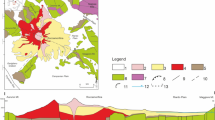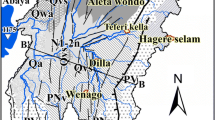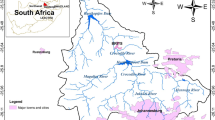Abstract
Large-scale interaction between the Continental Intercalaire and the Djeffara aquifer systems in the southeast of Tunisia has been investigated with the aid of chemical and isotopic tracers. Two distinct groundwater types have been identified: (1) the Continental Intercalaire groundwater characterized by elevated temperatures (50–61.4°C), low δ18O (−8.4 to−7.87) and δ2H (−67.2 to−59) values and negligible radiocarbon content, both testifying its great age dating from the late Pleistocene period, and (2) the Djeffara groundwater with distinctly heavier isotopic composition (δ18O = −8.31 to −5.80, δ2H = −65.9 to −31.9). The Djeffara groundwaters reveal a distinct changes of physico-chemical and isotopic parameters near El Hamma Faults in the northwestern part of the Djeffara basin. These changes could possibly be explained by a vertical leakage from the Continental Intercalaire aquifer through El Hamma Faults. The mixing proportions inferred from stable isotope mass balance prove that the contribution of the Continental Intercalaire to the recharge of Djeffara aquifer is very significant and may reach 100% in the El Hamma region and in the northern part of Gabes. Isotope tracers strongly suggest that recent recharge to the Djeffara aquifer system is very limited. Its current yield, particularly in its central and northern parts can be maintained only thanks to large-scale underground inflow from the Continental Intercalaire aquifer system, which carries late Pleistocene palaeowater. Consequently, current exploitation of groundwater resources of the Djeffara aquifer has non-sustainable character.









Similar content being viewed by others
References
Abidi B (2004) Caractéristiques hydrodynamiques et géochimiques de la Djeffara de Gabès. DGRE 2004, p 198
Benton MJ, Bouaziz S, Buffetaut E, Martill D, Ouaja M, Soussi M, Trueman C (2000) Dinosaurs and other fossil vertebrates from fluvial deposits in the lower creatceous of Southern Tunisia. Palaeolgeogr Palaeoclimatol Palaeoecol 157:227–246
Bouaziz S (1995) Etude de la tectonique cassante dans la plate-forme et l’atlas saharien (Tunisie Méridionale): Evolution des paléochamps de contraintes et implications géodynamiques. Thesis d’Etat, University of Tunis II, Faculty of Science of Tunis
Celle H, Zouari K, Travi Y, Daoud A (2001) Caractérisation isotopique des pluies en Tunisie. Essaie de typologie dans la region de Sfax. CR Acad Sci Paris 6:625–631
Charfi S (2004) Contribution à l’étude hydrogéologique, hydrochimique et isotopique de la nappe de la Djeffara de Gabès. Master degree, Laboratory of Radio-Analysis and Environment, National School of Engineers of Sfax, p 91
Chkir N, Zouari K (2007) Uranium isotopic disequilibrium for groundwater classification: first results on Complexe Terminal and Continental Intercalaire aquifers in Southern Tunisia. Environ Geol 53:677–685
Colpen TB, Wildman J, Chen J (1991) Improvement in the gaseous hydrogen-water equilibration technique for hydrogen isotopes ration analysis. Anal Chem 63:910–912
Coplen TB (1996) New guidelines for reporting stable hydrogen, carbon, and oxygen isotope-ratio data. Geochim Cosmochim Acta 60:3359–3360
Craig H (1961) Isotopic variations in meteoric water. Science 133:1702–1703
Dansgaard W (1964) Stable isotopes in precipitation. Tellus 16:567–584
Edmunds WM, Cook JM, Darling WG, Kinniburgh DG, Miles DL, Bath AH, Morgan-Jones M, Andrews JN (1987) Baseline geochemical conditions in the Chalk aquifer, Berkshire UK: a basis for groundwater quality management. Appl Geochem 2:275–284
Edmunds WM, Shand P, Guendouz A, Moulla A, Mamou A, Zouari K (1997) Recharge characteristics and groundwater quality of the Grand Erg Oriental basin. Avicennes, Technical Report WD/97/46R, Hydrogeology series, British Geological survey
Edmunds WM, Guendouz A, Mamou A, Moulla A, Shand P, Zouari K (2003) Groundwater evolution in the Continental Intercalaire aquifer of Southern Algeria and Tunisia: trace element and isotopic indicators. Appl Geochem 18:805–822
Epstein S, Mayeda TK (1953) Variations of 18O content of waters from naturel sources. Geochim Cosmochim Acta 4:213–224
ERESS (1972) Etude des ressources en eau du Sahara Septentrional. UNESCO, Paris
Fontes JC (1971) Un ensemble destiné à la mesure de l’activité du radiocarbone naturel par scintillation liquide. Rev Geog Phys Géol Dyn 13(1):67–86
Fontes JC (1980) Environmental isotopes in groundwater hydrology. In: Fritz P, Fontes JC (eds) Handbook of environmental isotope geochemistry. Elseiver Amsterdam 75–140
Fontes JC, Coque R, Dever L, Filly A, Mamou A (1983) Paléohydrologie isotopique de l’wadi el Akarit (Sud Tunsien) au Pléistocène at à l’Holocène. Palaeolgeogr Palaeoclimatol Palaeoecol 43:41–61
Fritz P, Hennings Cs, Suzuki O, Salari E (1979) Isotope hydrology in northern Chile. In: Isotope hydrology (1978) IAEA, Vienna 525–544
Gat JR (1981) Groundwater. In: Gat JR, Gonfiantini R (eds) Stable isotope hydrology. IAEA, Vienna, pp 223–240
Gonfiantini R, Conrad G, Fontes JC, Sauzy G, Payne BR (1974) Etude isotopique de la nappe du Continental Intercalaire et ses relations avec les autres nappes du Sahara Septentrional, IAEASM- 182/25. In: Isotope techniques in groundwater hydrology, vol I. IAEA, Vienna, pp 227–241
Gries S (2000) Etude isotopique et géochimique des nappes profondes au Sahara-Sahel, implications pour la gestion des ressources en eau et les reconstitutions paléoclimatiques. PhD thesis, University of Paris XI, Faculty of Sciences Orsay, Paris
Guendouz A, Michelot JL (2006) Chlorine dating of deep groundwater from northern Sahara. J Hydrol 328:572–580
Guendouz A, Moulla A, Edmunds WM, Shand P, Poole J, Zouari K, Mamou A (1997) Paleoclimatic information contained in groundwaters of the Grand Erg Oriental, N Africa. Isotope techniques in the study of past and current environmental changes in the hydrosphere and atmosphere. IAEA, Vienne, pp 555–571
Guendouz A, Moulla AS, Edmundo WM, Zouari K, Shand P, Mamou A (2003) Hydrogeochemical and isotopic evolution of water in the Complexe Terminal aquifer in the Agerian Sahara. Hydrogeol j 11:483–495
Ingerson E, Pearson FJ (1964) Estimation of age and rate of motion of groundwater by the 14C method. In: Recent researches in the fields of hydrosphere, atmosphere and nuclear geochemistry, Sugarawa festival volume Maruzen, Tokyo pp 263–283
Kallel R (2003) Hydrologie de la Jeffara tunisienne. Rapport interne. CRDA de Gabes
Maliki MA (2000) Etude hydrogéologique, hydrochimique et isotopique du système aquifère de Sfax (Tunisie). PhD thesis, University of Tunis II
Mamou A (1990) Caractéristiques, Evaluation, Gestion des ressources en eau du Sud Tunisien. PhD thesis. University of Paris South, Paris
OSS (2003) Système aquifère du Sahara Septentrional Une conscience de bassin. Vol II. Hydrogéologie. Observatoire du Sahara et du Sahel p 322
Plummer LN, Jones BF, Truesdell AH (1976) WATEQF, a Fortan IV version of WATEQ, a computer program for calculating chemical equilibrium of natural waters. US Geological survey water Res Invest 76:61
Rouatbi R (1967) Contribution à l’étude hydrogéologique du Karst en Terre de Gabès Sud. PhD thesis, Montpellier
Taylor CB (1976) IAEA isotope hydrology laboratory, technical procedure note no. 19. International Atomic Energy Agency, Vienna
Taylor CB (1977) Tritium enrichment of environmental waters by electrolysis: development of cathodes exhibiting high isotopic separation and precise measurements and Applications. High Tatras, Czechoslovakia, October 1975, Bratislava (1977), pp 133–140
Zouari K (1988) Géochimie et sédimentologie des dépôts continentaux d’origine aquatique du Quaternaire supérieur du Sud Tunisien. PhD thesis. University of Paris-Sud, Orsay
Zouari K, Chkir N, Ouda B (2003) Palaeoclimatic variation in Meknassi basin (Central Tunisia) during Holocene period using multidisciplinary approaches. IAEA, Vienna, pp 80–28
Acknowledgments
This study was carried out within the framework of the regional IAEA project RAF/8/035.
Author information
Authors and Affiliations
Corresponding author
Rights and permissions
About this article
Cite this article
Trabelsi, R., Kacem, A., Zouari, K. et al. Quantifying regional groundwater flow between Continental Intercalaire and Djeffara aquifers in southern Tunisia using isotope methods. Environ Geol 58, 171–183 (2009). https://doi.org/10.1007/s00254-008-1503-x
Received:
Accepted:
Published:
Issue Date:
DOI: https://doi.org/10.1007/s00254-008-1503-x




